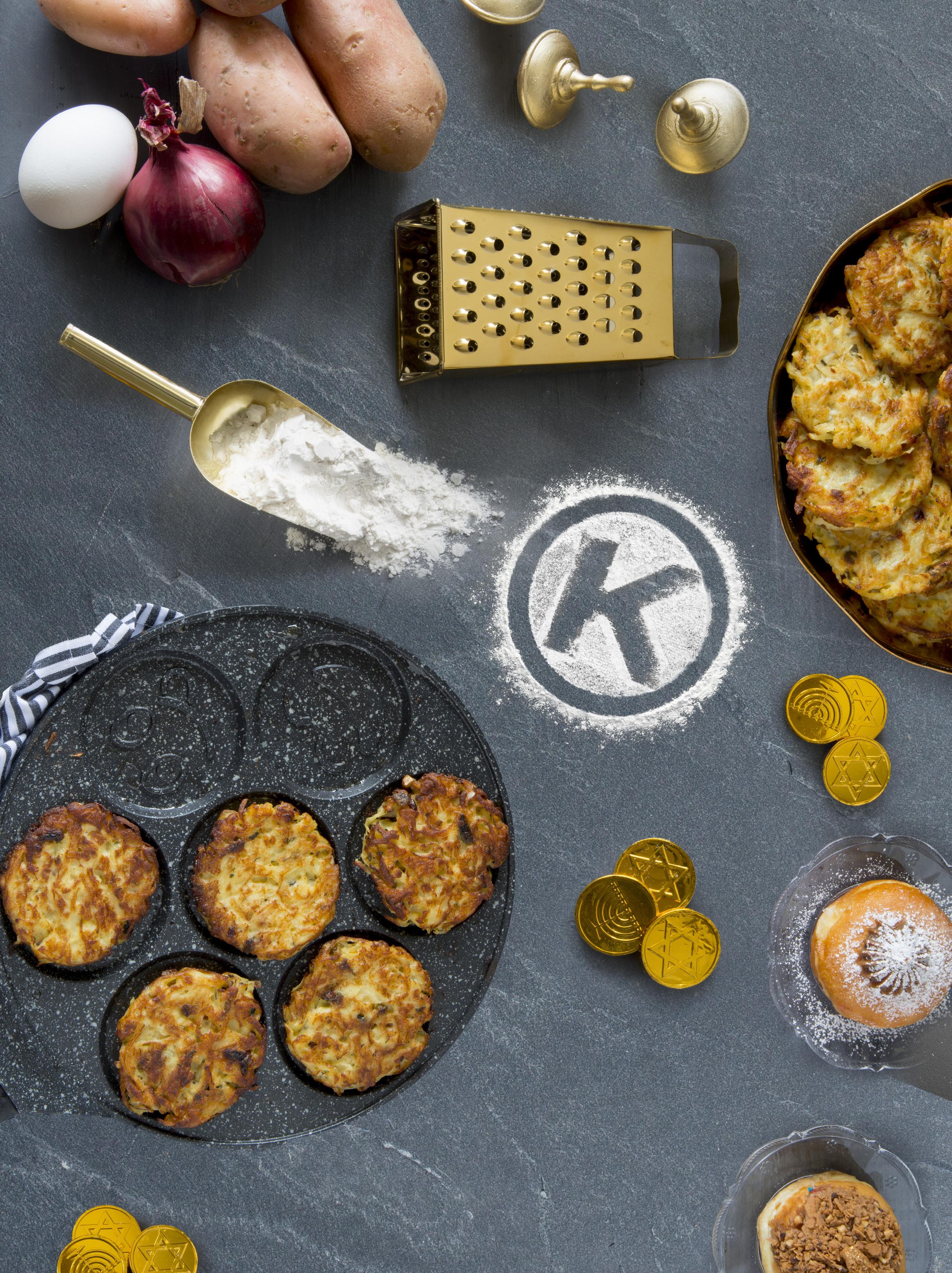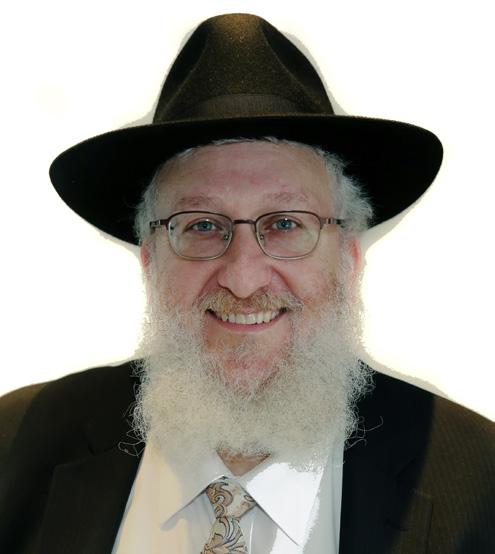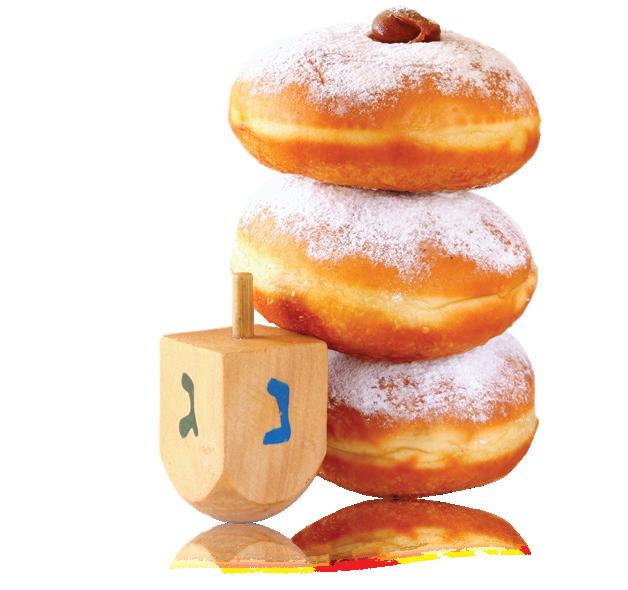
CERTIFIED SOUL NUTRITION KISLEV 5780
YOU A HAPPY CHANUKAH ה”ב פ”שת ולסכ הכונח ןכעליירפ א
WISHING
3 4 5 8 10 12 16 17 18 20 22 23
HEALTHY SPIRIT
ONLINE SMICHA
Bringing Practical Halacha to All
CHOLOV YISROEL IN CALIFORNIA
by Rabbi Shlomo Klein
182 WAYS ~ KOSHERED YOUR WORLD IN 2019
YOUR KOSHER KITCHEN: CONVECTION OVENS by Rabbi Sholom Ber Lepkivker
KEEPING KOSHER IN… ANTARCTICA
by Leibel Baumgarten
A CLOSER LOOK: OLIVES by Rabbi Sholom Ber Hendel
CHANUKAH RECIPE: WONTONS IN GARLIC SAUCE
GOING ABOVE AND BEYOND WITH BEYOND MEAT
by Miri Rotkovitz
WHO’S BEHIND THE ~ Interview with Rabbi Shlomo Weinfeld
CHASSIDIC INSIGHTS
Compiled by Dina Fraenkel
SOUL NUTRITION
by Rabbi Chaim Fogelman
Dear Reader,
This is the time of year that many businesses take inventory, reflect on the past year, and employees look to use up any unused vacation days; it seems like everyone is tying up the loose ends.
At the ~ we do our introspection and review all of our checks and balances in the month of Elul. This time of year we reserve to look to the future, and as we enter the month of Kislev, we join together with ~ rabbis from across the globe for our Annual Mashgiach Conference.
This year close to 200 members of the ~ team came together, from as close as Crown Heights, Brooklyn, NY, to as far away as South Korea, to catch up on the latest happenings in the world of kosher and in ~ headquarters. This year we focused on alcoholic beverages, and fascinating and informative lectures were given about all things alcohol: beer, whiskey, bourbon, and, of course, wine. Step-bystep instruction, supported with PowerPoint and video presentations, covered the latest manufacturing innovations and kashrus concerns. Rabbi Don Yoel Levy, Kashrus Administrator of the ~, was one of the speakers, reminiscing about the very first winery he visited, and with close to fifty years of hands on kashrus experience behind him there is much to learn from him. Mr. Simon Bergson, CEO of Manhattan Beer Distributors, the largest beer distributor in the tristate area, was recognized for selling his company’s chometz (even though Manhattan Beer is not in contract with a particular certifying agency). We all walked away at the end of the conference with a better understanding of the complicated world of alcoholic beverages, from production to the devastating effects of addiction.
KOSHER SPIRIT Chanukah 5780
EDITOR-IN-CHIEF:
Rabbi Chaim Fogelman

EDITOR:
Dina Fraenkel
DESIGN:
Spotlight Design
We welcome your comments, submissions and letters to the editor.
Mail: 391 Troy Avenue, Brooklyn, NY 11213
Email: editor@kosherspirit.com
© 2019. No portion of this publication may be
written consent
We all know the story of how Yehudis plied the Greek general with wine and cheese, in order to lull him to sleep so she could help achieve victory for the Maccabees. Dairy is king around Chanukah time – read about our latest kosher endeavor, Cholov Yisroel milk production for the West Coast market, as well as a unique plant based “meat” product, the pareve Beyond Meat line. In addition, if for some reason you need to kasher your oven for a Chanukah feast, you can learn more from the Your Kosher Kitchen feature on these pages.
Wishing your family a light-filled and joyous Chanukah.
Rabbi Chaim Fogelman Editor in Chief
the publisher.
reprinted without
from
2 www.OK.org
The miracle Of Chanukah and the defeat Of the Greek general Came about because oF Yehudis, the herOine who plied the general with dairY and wine in order tO make him fall asleep sO she could kill him. here’s 8 facts abouT one of The world’s mosT popular dairy products.
Yogurt
— One —
One cup of yogurt provides 49% of a person’s daily calcium needs.
— Two —
The calcium in yogurt signals fat cells to release less cortisol (a hormore which prevents weight loss), aiding in weight loss.
— Three —
Greek (strained) yogurt contains a higher concentration of protein and probiotics than standard yogurt.
— Four —
Yogurt is a great source of potassium, phosphorus, riboflavin, iodine, zinc and vitamin B5.
— Five —
The protein and carbohydrates in yogurt can help your body recover faster after a workout.
— six —
2-3 servings of low fat dairy per day (including yogurt) can bring up to a 50% reduction in the risk of developing high blood pressure.
— seven —
Yogurt with live active cultures can help gastrointestinal conditions, including lactose intolerance, constipation, and inflammatory bowel disease.

— eight —
Regular consumption of yogurt can help reduce the risk of type 2 diabetes.
www.KosherSpirit.com 3
Rabbi Shneur Zalman of Liadi is most well-known for authoring the Tanya, one of the cornerstones of Chassidic study. What is not as well known, is that his first printed work had a different focus altogether. Titled Hilchos Talmud Torah, this Halachic masterpiece details the obligation of Torah study as it applies to various types of people, as well as the priorities one must have in learning. One point that repeats itself over and over is that one’s first obligation is to learn those parts in Torah that have a day to day application, i.e. Halacha (Jewish law). Without learning those laws, one cannot properly live as a Jew.
One of the areas of the Jewish home which can be the most complicated is the kitchen. The laws of kosher are numerous and complex, and can seem like a maze to those who are unfamiliar. In addition to the requirements for the actual food products to be kosher, there are Torah mandated laws regarding the actual cooking process, as well as the strict separation of milk and meat. In order to keep track of the numerous details necessary to keep a kosher kitchen, and to know what problems may arise and how to deal with them, one must be a “rabbi in his home”.
However, learning these halachos may seem like an insurmountable challenge, even for those with a solid yeshiva education. One must be familiar with the style of the Shulchan Oruch and its commentaries, with each commentator’s unique way of writing and bringing their point across. For one who never had the chance to immerse in intensive Torah study or the opportunity to delve into Halacha, the crucial halachos necessary to keep a kosher home may seem inaccessible.
Online Smicha provides a unique opportunity for anyone who desires to learn. Utilizing advanced technology to bring together students from around the globe, Online Smicha creates a virtual classroom. This unique program enables one study towards smicha (rabbinic ordination) from the comfort of one’s home. The excellent staff is headed by Rosh Yeshiva, Rabbi Nachman Wilhelm, who is well known for his clear and lucid explanations, taking these complex laws and bringing them to life, making them understandable to the average layman through day-to-day examples, visual aids, and interactive work.
For some students, this learning opportunity has given them back the enjoyment in learning.
“I really wasn’t sure what to expect going into it. I haven’t felt a “geshmak” of goal oriented learning like this in a long time. I also have to say that it is rare to have such a dynamic and energetic Maggid Shiur.”
—Mr.
Yisroel Farbman of New York
“I must say that the program, either for smicha or for reviewing one’s learning, is a very structured and enjoyable tool.”
—Dr. Chaim Bitton of Zurich, Switzerland
In addition to the regular Smicha Program, there is a fast track for more advanced study as well as a bi-weekly shiur in Kitzur Shulchan Oruch for more basic study sessions.
Online Smicha makes learning complex halachos accessible to Jews of all walks of life, regardless of previous Torah learning experience.

We are proud to utilize the latest technology to enable others to be kove’a itim, setting aside set times for Torah study, and learn the halachos needed to live as a Jew. ~
www.onlinesmicha.com
4 www.OK.org
Walk into any kosher grocery or supermarket in Los Angeles or surrounding communities and you have not just one, but a choice of two, brands of fresh, local, ~ certified Cholov Yisroel milk. While it may seem strange to get excited about a simple cup of milk, for many people in these communities this has been a long-awaited dream come true.
California is the largest producer of milk in the US, with dairies that produce more milk than

in California
by Rabbi Shlomo Klein, Rabbinic Coordinator
all eleven northeast states combined. However, producing Cholov Yisroel milk in California has always been a significant challenge.
According to halacha (YD 115:1), milk is considered kosher only when the milking is supervised by a mashgiach to ensure that milk from non-kosher animals was not blended into the kosher milk. Many communities throughout the world follow Rav Moshe Feinstein’s leniency (Igros Moshe YD 1:47-49) that when there is proper government control of the dairy industry with adequate inspections, we can safely assume that milk, labeled as milk, is 100% from a cow. Rav Moshe rules that this absolute knowledge is the halachic equivalent of a mashgiach witnessing it. Such milk is commonly referred to as cholov stam (regular milk).

However, Rav Moshe (YD 2:35 and 4:5) limits this leniency to circumstances where CY is difficult to obtain. In addition, many communities follow the ruling of other
major poskim that do not agree with Rav Moshe’s approach1.
The ~ and most other kosher agencies certify cholov stam to provide dairy products to those who do rely on Rav Moshe’s ruling. These products are labeled as ~-D. The ~ certified Cholov Yisroel products have the words Cholov Yisroel or לארשי בלח clearly printed on the label. ~ certified food service (dairy restaurants and catering) are always Cholov Yisroel.
Kehilla of Los Angeles was established by Rav Avrohom Teichman in 1979. One of its first missions was to help introduce fresh and reliable Cholov Yisroel milk to the wider community. In 1981 a company named Quality Kosher was established and produced Kehilla certified Cholov Yisroel milk at Norwalk Dairy (after a brief stint at Chase Bros. Dairy in Oxnard). This lasted for over 20 years. In 2013 Norwalk Dairy closed shop leaving the West Coast communities without a viable option for local, fresh Cholov Yisroel milk.
At that point, distributors started to import milk from the East Coast. However, due to the travel time and handling throughout the shipment, the quality of the milk was subpar. The Cholov Yisroel community became accustomed to “there is no milk” due to the truck being bogged down in
6 www.OK.org
םיסומכ םימעט שיש ובתכ דועו .אכ 'יס ב"ח קחצי תחנמ ע"עו .חל 'יס א"ח הרות ןינק ת"וש ,חכ 'יס 'יס ד"וי םיחקרמ תולדגמ ,ול 'יס ד"וי רפוס תעד ,ד"ל 'יס ד"וי בקעי תקלח .1 .ג"מר 'מע ז"ט קלח )ד"בח( שדוק תורגא םימכח ירבד ךרע ץעוי אלפ ,אפ ףד א"ח רפוס םתח תושרד ,'נ תוא םייח יכרד ו"ס וטק 'יס ד"וי ןחלושה ךורע 'יע יוג ובלחש בלח רוסיאל םיימינפו
a Midwest snowstorm or because vacationers emptied out the grocery refrigerators. Additionally, shipping caused an increase in price on the already more costly Cholov Yisroel milk.
All the above reasons caused many people who would have otherwise consumed Cholov Yisroel milk to go out and buy Cholov Stam milk instead.

Several attempts to produce Cholov Yisroel milk locally failed. People invested time and money to explore different options. The main challenge is that most farmers are not processing the milk themselves anymore, but are selling it to 3 large co-ops – CDI, DFA and Land O’Lakes. These co-ops collect the milk from over 1,500 farms and sell it to large dairies and cheese plants for processing. This makes it extremely difficult to ensure that the Cholov Yisroel milk will not be compromised as it flows through the multiple pipes, tanks, tankers, and processing equipment.

Two companies, Kosher Pastures and La Crème, did not give up and with great effort and Siyata Dishmaya they reached their goal at around the same time. While there are some differences between the two, their kashrus standards are equally the highest and without compromise. The ~ monitors veterinarian records to ensure that there are no DA cows on the farm2. Before every Cholov Yisroel production all equipment (pipes, tanks, tankers, pumps, chillers) are cleaned and sanitized, and filters are replaced. Heated equipment is kashered at boiling temperatures (212o)3 and is done after a 24-hour downtime (Eino Ben Yomo). Most importantly, we have highly skilled mashgichim, respected Yerei Shomaim, who keep Cholov Yisroel in their own homes, supervising the milking from the beginning until the end.
2. Cows that suffer from displaced abomasum (DA) are commonly treated by securing the abomasum to the body wall with a blind tack (a holding stitch placed in the abomasum without opening the belly). Poskim debate if this procedure renders the cow as Halachically treif and by extension the milk would not be kosher (see Mishne Halochos 13:113 and Shulchan Halevi Birurei Halocho 15)

Fortunately, DA is extremely rare in warm climates because one of the leading causes for this condition is harsh weather. This is evident by the fact that most of the DA complications occur in the winter months.
3. Several kashrus agencies allow Kashering at 190º (דכר 'מע א"ח יולה ןחלש 'יע). ~ policy always requires 212º (or elevation adjusted boiling point) for kashering.
4. ראובמ ןכו .ותורכשל הניבג ותוא הליכאהש (י"קס ע"רת 'יס) ב"נשמב אבוה (ף"ירה יפדמ .י תבש) םיסינ וניבר 'יע (נ"שו .ד ריזנ) רכשמה הקשמ בשחנ בלחד תומוקמ המכב
www.KosherSpirit.com 7
The Chanuka story of Yehudis killing the Greek general after feeding him cheese shows that milk has intoxicating properties 4; therefore, let us raise a glass of milk and say L’chaim! ~
KOSHER CERTIFICATION
NEW COMPANIES 2019
ADDITEX BVBA
BELGIUM
AGROPUR INC IOWA
AL KENANA COMPANY EGYPT
ALPINE DAIRY OHIO
AMEVA MEDITERRANEAN FOR FOOD INDUSTRIES EGYPT
AMYRIS INC. CALIFORNIA
ANABIO TECHNOLOGIES DUBLIN
BAGELWAY DBA SABABAWAY FLORIDA
BBI COLOMBIA S.A.S. - CAFŽ KUMANDAY COLOMBIA
BEADED DISTRIBUTION COMPANY ILLINOIS
BEK12INC ILLINOIS
BELOOR BAYIR BIOTECH INDIA
BEST PRACTICE FLORIDA
BIBIS CAFE & BAKERY CALIFORNIA
BIMBLE BEVERAGES NEW YORK
BIOCHEM ITALY
BITCHIN SAUCE CALIFORNIA
BUCKMAN
LABORATORIOS LTDA BRAZIL
CAIRO 3A
EGYPT
CAKE CRAFT FACTORY TEXAS
CAMINOS DEL SOL COSTA RICA
CASA VITIVINICOLA
TINAZZI ITALY
CASCATA PACKAGING, LLC UTAH
CILIONE SRL ITALY
CLEARFAST INC CALIFORNIA
COLD BREW VENTURES/BACK BAY ROASTERS & BREWERS MASSACHUSETTS
CONSORCIO LICORERO NACIONAL, SA PANAMA
COOP. EXTREME–A DE AJOS DE ACEUCHAL, S.COOP.
SPAIN
CRUST BAKER NEW YORK
CYMBIO PHARMA INDIA
D.S.R. SAHAR ISRAEL
DE STILLE KRACHT B.V. HOLLAND
DOEHLER INDIA PVT. LTD.
INDIA
DR. SCHAR DEUTSCHLAND GMBH
GERMANY
DRAKE’S ORGANIC SPIRITS LLC
MINNESOTA
DSM FOOD SPECIALITIES B.V.
STRAIN CONSERVATION UNIT (SCU)
NETHERLANDS
EFFEPHARM (SHANGHAI) CO., LTD.
CHINA
EL SATIVO
NEVADA
EMAMI AGROTECH
LIMITED
INDIA
ENORICA GMBH
GERMANY
ETROG RESTAURANT & CATERERS NEW YORK
EXTRACTORA DEL ATLANTICO GUATEMALA
EXTRACTORA LA FRANCIA S.A.
GUATEMALA
FAIRVIEW SWISS CHEESE PENNSYLVANIA
FLORIDA PRODUCTS S.A. COSTA RICA
FOOD AEROSOLS SPAIN, S.L. SPAIN
FOODS FOR FUNCTION COLORADO
FREE TO EAT, INC. CALIFORNIA
FREEYUMM FOODS LTD.
CANADA
FRUGAM FRANCE
FUJIAN UNILAND FOODS CO., LTD.
CHINA
GAMGAM COMERCIO DE BALAS E PIRULITOS LTDA BRAZIL
GEORGE CALIL LIMITED NIGERIA
GLICKS FLORIDA
GLOBAL GROUP ARGENTINA
GREENVILLE VENTURE PARTNERS MICHIGAN
GROVE KOSHER MARKET
FLORIDA
GUANGXI SUNGAIN BIOTECHNOLOGY
CHINA
GUANGXI SUNGAIN
YEAST
CHINA
GUANGZHOU CARDLO BIOTECHNOLOGY CO. LTD.
CHINA
GUANGZHOU JINQUAN BIOCHEM TECHNOLOGY
CHINA
HARMONY FOUNDATION OF NEW JERSEY NEW JERSEY
HEALTH GARDEN
NEW YORK
HEXAGON NUTRITION INDIA
HOWENIA ENTERPRISE TAIWAN
HPPE GEORGIA
HUBEI WELL-BEING BIOTECHNOLOGY CO., LTD.
CHINA
INBITE GF INC.
FLORIDA
INDUBAN DOMINICAN REPUBLIC INTERTAPE POLYMER CORP
FLORIDA
JIANGXI ZHONGTIAN AGRICULTURAL & BIOLOGICAL ENGINEERING CO.
CHINA
JIN HAU MAJESTIC ALUMINUM PACKING CO.
CHINA
JOHNSON MATTHEY CHEMICALS INDIA
JOOLIES, LLC CALIFORNIA
JOOSSE TRUCKING WISCONSIN
JW NUTRITIONAL TEXAS
KAM INC. NEW JERSEY
KAVANA ENTERPRISES INC. OKLAHOMA
KC GLOBAL NETWORK CALIFORNIA

KERRY INGREDIENTS INDIA PRIVATE LTD. - FLAVORS INDIA
KITOZYME SA BELGIUM
KODIAK CAKES UTAH
KOREA SANGWHANG MUSHROOM CO. LTD. SOUTH KOREA
KOSHER PASTURES CALIFORNIA
KOSHER PIZZA PLUS NEW YORK
LA CR ME CALIFORNIA
LANDMOLKEREI HAGENOW GERMANY
LIFE ZONE UTAH
LINYI CITY KANGFA FOODSTUFF DRINKABLE CO., LTD. CHINA
LLC GEORGIAN INDUSTRIAL ASSET MANAGEMENT GROUP
GEORGIA
LONESTAR FAMILY FARMS TEXAS
LYANATURE CO., LTD. SOUTH KOREA
M/S GOODRICKE GROUP INDIA
MAMAGONNAWIN
LLC DBA GRAIN FREE MAMA’S NEVADA
MASPEX POLAND
MEDIMAX CALIFORNIA
MICHTER’S DISTILLERY KENTUCKY
MICROTEC GERMANY
8 www.OK.org
182 WAYS ~ Koshered your world in 2019!
MILE HIGH LABS COLORADO
MUCCA CALIFORNIA
MYEONG SHIN AGAR AGAR SOUTH KOREA
MYLK LABS CALIFORNIA
NATIVE FLAVORS BRAZIL
NATURAE LLC NEW YORK
NATURZ ORGANICS (DALIAN) CO. LTD. CHINA
NEO CREMAR CO. LTD. SOUTH KOREA
NINGBO MEITAO PLASTIC TECHNOLOGY CO. CHINA
NOVAREX CHINA
NUT HAVEN NEW YORK
NUTRAONLY (XI’AN) NUTRITIONS INC.
CHINA
NUTRISHUS BRANDS INC.
GEORGIA
NUTTEE BEAN CO. LLC USA
FLORIDA
ODYSSEY FOODTRANS FLORIDA
PASTRY CHEF NEW JERSEY
PHASE 2
OREGON
PHOENIX CHEMICALS NEW JERSEY
PILIPINAS KAO PHILIPPINES
PIZZA MARK CALIFORNIA
PLANT PERKS MONTANA
PRISTINE ORGANICS INDIA
PT CITRA BORNEO
UTAMA INDONESIA
PT SIN A SIXFIFTEEN INDONESIA
PT. INTRAFOOD SINGABERA INDONESIA
PT. SAWIT ASAHAN TETAP UTUH INDONESIA
QUALITY LIQUID FEEDS WISCONSIN
QUESTO QUELOTRO SAPI DE CV MEXICO
QUINTESSENCE NUTRACEUTICALS INDIANA
RAD EXTRACTS COLORADO
RAGA GLOBAL TRADING ISRAEL

RAY’S FOODS PENNSYLVANIA
REIFON BIOTECH CHINA
RESEARCH CENTER WEIHENSTEPHAN FOR BREWING & FOOD QUALITY GERMANY
RICHARDSON OILSEED PRODUCTS
RICINASH OIL MILL INDIA
RISTRETTO IMPORT & MARKETING LTD. ISRAEL
RIVOUSA CALIFORNIA
SABAD FOODS CALIFORNIA
SAMI’S GRILL CALIFORNIA
SAMI’S MAKOLET CALIFORNIA
SATTVA VIDA NEW YORK
SBK PRESERVES NEW YORK
SEEDERY CO NEW YORK
SELEME SELEME CIA LTDA BRAZIL
SHANKAR NUTRICON INDIA
SHANKAR SOYA CONCEPTS INDIA
SHANTI OVERSEAS INDIA
SHANTOU TEMPTED FOOD INDUSTRIAL CO. LTD. CHINA
SHEANDRO FLORIDA
SHILOH SUSHI BLEU NEW YORK
SHIVAM OILS & PROTEIN INDUSTRY INDIA
SIGNATURE BREADS MASSACHUSETTS
SIMRAN NUTRIFOODS INDIA
SIRANE UNITED KINGDOM
SOLUTASTE BRAZIL
SPECTRUM BAKES NEW YORK
STRIP SNACK NEW YORK
SUHAND CHEMICALS INDIA
SUIZHONG SONGZHIYUAN VEGETABLE PROTEIN CO., LTD. CHINA
SULA PLUS BELARUS
TC DAUBERT PENNSYLVANIA
THE BAY CAFŽ NEW YORK
THE BOOZERY NEW YORK
THE GROVE FLORIDA
THE SNACKATERE NEW JERSEY
TONNELLERIE SYLVAIN FRANCE
TOONIE MOONIE ORGANICS NEW YORK
TOP FOODS CHINA
TROPICAL GREEN ORGANICS VIRGINIA
UNITED LABORATORIES MANUFACTURING LLC TEXAS
VALLEY SHEPHERD CREAMERY NEW JERSEY
VIDYA HERBS PVT LTD. INDIA
WEISHAN CIWAY FOOD CO. LTD. CHINA
WELLWELL NEW YORK
WEST VIRGINIA POTATO CHIP COMPANY WEST VIRGINIA
WESTALISCHE LEBENSMITTELWERKE LINDEMANN GMBH & CO. KG GERMANY
WING WAN FOODS DBA TA’AM OF CHINA NEW YORK
WISE WOMAN HERBALS OREGON
XINGHAU DONGAO CHINA
YOUR LOCAL GREENS NORTH CAROLINA
YUYAO GUMANCANG FOOD CO CHINA
ZAKLAD PREZETWORSTWA OWOCOW - WARZYW POLKON POLAND
CERTIFICATION www.KosherSpirit.com 9


































































Rabbi Sholom Ber Lepkivker, Rabbinic Coordinator 10 www.OK.org
Kosher Kitchen your Convection Ovens
What are convection ovens?

Convection ovens (also known as “fan ovens”) are a fairly new addition to the kitchen, compared to traditional ovens, making their first appearance around 1914.
The idea behind the convection oven is that it provides an even circulation of hot air, so the product is baked and browned evenly (and not burnt on one side) and in less time than a traditional oven.
There are some additional varieties of convection ovens, but they all use the same basic mechanism of a fan blowing hot air.
Convection ovens have the same basic kashrus requirements as a traditional oven – it should be dedicated to either meat or dairy, etc.
What do I do if I want to kasher a convection oven?
When it comes to kashering any oven, one first needs to determine the kind of kashering that is required. This would depend on its previous use, as well as the durability and functions of the oven.
Assuming one is asking about a regular oven which also has the convention function:
If you kasher the oven from real treif, for example if you purchased the oven from a non-Jew who most
probably used it for things similar to pork, etc., the oven racks, fan and anywhere else grease might touch and reach, would require a full libun. This means that one would need to use a blow torch 1 or other means of live fire2, unless the oven has a self-cleaning function that reaches a temperature of 500°C. Anywhere else, a libun kal would suffice (see below).
If you are not kashering from treif; rather you need to use your milchig or fleishig oven for pareve, which essentially means that the oven is already kosher, a libun kal would suffice for everything. The oven needs to be completely clean, the fan either cleaned, or if not possible, sprayed with a cleaning chemical (to make it pogum), and it’s best to make sure that it hasn’t been used for at least 24 hours. In the kashrus world the accepted temperature for a libun kal is around 290°C (550°F). The oven needs to be run at this temperature for at least 1 hour.
Convection microwaves and portable convection ovens don’t usually have a self-cleaning option and the parts probably won’t stand the intense heat of a blow-torch, so they generally cannot be kashered from treif. Kashering from meat to dairy (or vice versa) would be done the same way as with a full size convection oven. If the oven cannot reach the correct temperature (550°F), it’s better not to kasher at all, but to buy a new oven.
1. Generally, 10 seconds with a blow torch (on every part), is enough.
2. Such as stove top (until the metal is discolored).
www.KosherSpirit.com 11
KEEPING KOSHER IN ANTARCTICA
By Leibel Baumgarten
“Paging passenger Daniel Eleff, please report to the police department in the main terminal immediately.” Eleff, more widely known in the Jewish world as “Dan” from his famed travel and deals site, dansdeals. com, began sweating profusely.
Together with Moishie Hersko of Kosher Horizons, Dan was leading a 51-person expedition on a cruise to Antarctica. The cruise would leave from the port in Ushuaia, Argentina, the southernmost tip of South America, which has highly restric-


12 www.OK.org
12 www.OK.org
tive rules about the food allowed to be brought in - no fruit, vegetables, or red meat. When checking in, however, airline officials informed Dan that no matter what rules were stated on the official website, they would not allow any food at all on the flight to Ushuaia. After moving the food to a different passenger’s bag who checked in without incident, they figured they were in the
But then came the ominous
The group was to be in Ushuaia overnight before boarding the cruise ship. The trip cost hundreds of thousands of dollars and had been two years in the making. Starting off without food for the first day would be a disaster. Nervously, Dan made his way from the gate area to a restricted security area where he was sternly informed that the milk in his suitcase would be confiscated.
Though inconvenienced, Dan breathed a sigh of relief that the rest of the food was safe, and thusly the trip kicked off in Ushuaia on the last night of Chanukah where the group lit the candles while enjoying latkes and applesauce.
Antarctica had long been a bucket list destination for Dan and Moishie, but always seemed out of reach, even for these seasoned travelers. Dan has seen the volca-



noes in Hawaii, enjoyed over-thewater bungalows in the Maldives, and snorkeled with the jellyfish in Palau, while Moishie has led photography trips chasing auroras in Iceland, polar bears in Svalbard, and photo journaling Havana, Cuba. But the logistics of keeping kosher in Antarctica were altogether different.
The only way for Shabbat observant Jews to see Antarctica is by cruise line, and passengers are not allowed to bring their own food and are certainly not able to use kitchen space and equipment to cook, reheat or refrigerate food. Realizing that the only way it could be done was with a large enough group that a cruise line would facilitate kosher catering, Moishie sent Dan a message asking what he thought about leading a kosher cruise to Antarctica. Within seconds, Dan was emphatically on board.
Still, putting the trip together was a daunting challenge. They’d have to find a willing cruise line, navigate an almost endless list of halachic challenges - when does Shabbat start or end in a place where the sun doesn’t set? - find a caterer, and sign up enough passengers willing to spend thousands of dollars on the once-in-a-lifetime adventure.
In the two years spent planning the trip, only one cruise was sched-
www.KosherSpirit.com 13
www.KosherSpirit.com 13
uled to depart and return to Ushuaia on a schedule that would allow for keeping Shabbat. Luckily, that cruise was willing to host a kosher group, and the project was underway!
Kosher cruising presents a very unique set of kashrus challenges, including kitchens and dining rooms on separate floors of the ship. With so many passengers, kitchens and dining areas, it is very difficult to ensure that ingredients and utensils are not inadvertently mixed up. The organizers felt that cooking in a shared kosher and non-kosher kitchen would prove to be too problematic and sought out a caterer to pre-cook and freeze gourmet meals worthy of the trip’s price tag.
They likely didn’t realize how prescient that thought was. In December of 1998 a tour operator arranged a kosher cruise to Antarctica by way of Cape Town. They enlisted kosher supervision, and my father, Rabbi Yossi Baumgarten, Principal Rabbinic Supervisor for more than thirty years, served as the mashgiach. The trip was fraught with kashrut challenges. For one, after receiving assurances that there would be a separate kosher bakery oven, it turned out one level of the eight tier oven was designated for kosher use, which was completely unsuitable for kosher baking.


The ship’s home port was Canada, and so for practicality’s sake they needed a Canadian caterer. Highly recommended, Dan reached out to a Montreal based caterer, Shua, with the message, “How adventurous are you?”
“Shua thought of everything,” said Dan. “Besides for fantastic food, the little things really enhanced the experience, like mini dairy chocolates for the Chanukah party.”
The food was prepared in the caterer’s kosher kitchen, and on the cruise a friend of Dan and Moishie, was enlisted as a fulltime kosher supervisor.
“Before the trip, I sat down with my personal Rabbi, who is an expert on kosher supervision. He went through everything I would have to look out for and the various challenges that could crop up.”
The kosher group was given brand new cutlery and crockery for the trip, as well as a separate kitchen and dedicated crew
14 www.OK.org
members for service and cleaning. Even so, on a ship out in the South Atlantic, there aren’t many options, if any, for an emergency contingency plan. While a kosher coffee station would usually make do with disposable spoons and coffee stirrers as it is used after passengers have eaten meat or dairy, the eco-friendly ship did not carry disposables at all.
When the cruise was set to depart, there was a fuel shortage in Ushuaia which sent cruise lines scrambling for solutions. The captain opted to divert to the Falkland Islands. While some passengers fretted over losing time in Antarctica, the diversion proved fortuitous for the kosher group, as the mashgiach was able to go shopping for disposable spoons and other kosher food and supplies, and passenger Levi Benjaminson printed a Tanya while on the ground.

Another issue could have been running out of supplies, but thankfully the only occurrence of that was margarine, which left the mashgiach emptying dozens of single serving margarine packets until he had scooped out enough for the meal.
The group was made up of observant Jews of every stripe; Chabad, Gur, Bobov, Skver, Satmar, Yeshivish, Yekkish, Modern Orthodox and others. “Shabbos in Antarctica was one of the most beautiful in my life,” says Moishie. “As we began the Shabbat prayers, a light snow began to fall. The juxtaposition of praying of all kinds of Jews and looking out to see stunning glaciers in their splendid grandeur was breathtaking.”
Keeping Shabbos on the cruise had numerous challenges. How does one light Shabbat candles in a flame-free environment? The passengers used electric incandescent candles, and the organizers would neither confirm nor deny that one of the women on board lit candles in her room on behalf of the other passengers.


On the 1998 cruise they couldn’t rely on electric candles for Chanukah. The captain allowed for menorahs to be kindled on the deck for a maximum of 30 minutes but assigned no fewer than four crew members to stand guard with fire extinguishers at the ready. “There were about 40 passengers on the kosher cruise,” said Rabbi Baumgarten. “But for the menorah lighting we had 500 people join us, a number of whom were Jewish but not part of the kosher cruise.”
The 2018 cruise also sought out Jewish passengers who weren’t in the kosher group, putting on Tefillin with some of the men, including the cruise line owner who is Jewish and was on board. Former Canadian Prime Minister Stephen Harper was on the cruise and was glad to meet the kosher contingent and proudly wore the cruise yarmulke he was given as a gift.
Though it took two years to arrange and the challenges were numerous, including a 25 hour fast on the 10th of Tevet while passing through the infamous Drake Passage, one of the roughest stretches of ocean in the world, by all accounts, the trip exceeded expectations.

“Somewhere along the way, a group of strangers became a family,” said passenger L. E. Nizhnikov. “I could write hundreds of pages about the untamed wilderness we explored and the wonders we encountered. The true beauty of this journey, however, was in the holiness and unity that our group brought to every port of call.”
Editor’s Note: It is extremely difficult to certify a cruise ship that is not completely dedicated to kosher. There are numerous kitchens and dining rooms and very little space is reserved for the kosher preparations. The limited supplies and busy dining rooms make it very difficult to prevent mixups and devise new plans. ~
www.KosherSpirit.com 15
PHOTOS: MOISHIE HERSKO
Olives
WHAT ARE OLIVES:
Olives are small, green fruit that grown on trees in Eretz Yisroel and around the world. They are one of the Shivas Haminim mentioned in the Torah.
Olives are not edible raw due to their bitter taste. About 90% of the world’s supply of olives is crushed into olive oil. The remaining 10% is processed into green and black table olives. Olives have many health benefits and can be eaten as is or used in foods, such as salads, toppings and dips.
HOW OLIVES ARE PROCESSED:
Olives are harvested from the trees and transported to manufacturing facilities. Upon arrival, foreign materials such as dirt and leaves are removed and the olives are washed with water. The olives are then placed in large tanks or barrels with a brine made from salt water and other additives. The olives are kept in the brine until the fermentation (curing) process is completed. The length of the process is dependent on the specific variety of the olives and the desired finished product. During the fermentation process, additional salt is added continuously. At the end of the process, the olives are removed from the brine, rinsed with clean water and sorted according to size. At this point, the olives can be cracked, pitted and stuffed and are subsequently packaged in jars or cans with the previously used or new brine. Olives that are sold in retail packaging are usually sterilized in hot water, or preservatives are added to the final brine.
Although dissimilar in appearance, green and black olives come from the same tree. Green olives are essentially unripe fruit. If they are kept on the tree for a longer period of time, they turn purple and then black. At this stage, they are picked and processed. Some varieties of black olives are processed by soaking green olives in a lye (Sodium Hydroxide) solution until the desired color is achieved.
Some olives go through a dry fermentation process that consists of placing the olives in a barrel with dried salt, which breaks down the bitterness. The barrels are mixed daily for a few weeks until the fermentation process is completed, after which they can be packed either dry, in a brine or processed further with vegetable oil.
Pimento (pepper in Spanish) Olives are pitted olives that are stuffed with pepper. Historically, strips of pepper were placed inside the olive and this method is still used today in some products. Presently, many pimento olives are stuffed with minced pepper, mixed with gelling agents.
ARE OLIVES KOSHER?
The olives themselves (unless they were grown in Israel [see below]) do not cause any kashrus concerns. However, most of the additives that are typically used in the fermentation or packaging brine pose kashrus concerns and care must be taken to ensure that they are sourced from a kosher approved supplier. The most common additives are: citric acid, ascorbic acid, lactic acid, acetic acid or vinegar1. Vegetable oil and seasonings can be added to the packaging brine. The gelling agent in the Pimento Olives is another kashrus concern.
Kalamata Olives come from Greece and are often packaged in vinegar. Since much of the vinegar used in Greece is wine vinegar, these olives pose a greater kashrus concern.
Olives that are grown in Israel pose additional kosher concerns. We must ensure that the olives did not grow during the Shmitta Year, and that Terumos U’maasros were taken from them. Even though olive trees do not typically bear fruit during their first few years after planting, there are some varieties that can bear fruit in their third year and, therefore, we must ensure that the olives are not Orlah (fruit produced by a tree during the first three years after planting).
Olives should be purchased solely from companies with reliable kosher certification. The kosher certifying agency will ensure that all of the additives are kosher and that non-kosher is not processed on the same equipment without a proper kosherization (if required). ~
16 www.OK.org 16 www.OK.org a
closer look
Rabbi Sholom Ber Hendel, ~ Rabbinic Coordinator
1. To read more about the kashrus concerns of vinegar, see page 7 in the Kislev 5778 Issue of the Kosher Spirit.
Wontons in GARLIC SAUCE
MEAT YIELD 10 - 12 SERVINGS
This recipe began with my obsession with wontons and garlic sauce from a particular Chinese restaurant that’s nowhere near my home. Naturally, I had to recreate it myself. Since then, these wontons have become the stuff of Pascal family legend. It’s my family’s all-time favorite Yom Tov appetizer. The only downside? It’s pretty much guaranteed to upstage basically any other dish you serve at the same meal!
WONTONS
1½ pounds ground beef
2 Tablespoons soy sauce
½ teaspoon toasted sesame oil
2 Tablespoons sesame seeds, preferably a mix of black and white
4 scallions, sliced
4 cloves garlic, minced
50 wonton wrappers, approximately
GARLIC SAUCE
1 (18-ounce) jar hoisin sauce
1/3 cup soy sauce
1/3 cup rice vinegar
1/3 cup honey
2 teaspoons sriracha
1 teaspoon ground mustard
½ teaspoon ground ginger
½ cup water
12 cloves garlic, minced
sliced scallions, optional, for garnish
additional sesame seeds, optional, for garnish
DIRECTIONS
1. Prepare the wontons: Combine beef, soy sauce, sesame oil, sesame seeds, scallions, and garlic in a large bowl; stir gently until just combined
2. Place about 2 teaspoons meat mixture onto the center of a wonton wrapper. Brush a small amount of water along the edges before pressing them together to help keep them sealed; bring the edges together to form a wonton. Set aside; repeat with remaining meat and wonton wrappers.
3. Bring a pot of salted water to a boil. Drop a few wontons into the boiling water; cook for about 6 minutes, until the meat is cooked through. Work in batches to avoid overcrowding the pot. Remove wontons with a slotted spoon; place on parchment paper, not touching each other. Set wontons aside.
4. Meanwhile, prepare the garlic sauce: Combine all sauce ingredients in a medium pot. Bring to a boil, then reduce heat; simmer mixture for about 15 minutes, stirring occasionally, until sauce thickens.
5. Just before serving, toss cooked wontons in sauce; warm through. If desired, garnish with sliced scallions and sesame seeds.

Plan Ahead Wontons can be frozen, without sauce, either before cooking (boil just before serving; if boiling frozen, add 1 minute to cooking time) or after cooking. Sauce can be prepared up to 3 days ahead and stored in the fridge. Combine wontons and reheated sauce just before serving.
Reproduced from More Real Life Kosher
Cooking By Miriam Pascal with permssion of the copyright holder ArtScroll/ Mesorah Publications Ltd.
www.KosherSpirit.com 17 RECIPE
by Miri Rotkovitz,
If you find it hard to imagine going a day without meat, you’re not alone. According to USDA statistics, the average American will consume over 217 pounds of meat in 2019. Yet according to the Dietary Guidelines for Americans, the total daily recommendation for all protein foods (including eggs, beans, and legumes) tops out at 6 ounces – or about 137 pounds a year for most adults. Simply put, many of us eat far more meat than we need, and that has implications not only for our personal health, but for that of the planet.
Enter Beyond Meat, a missiondriven company that’s keen to change that equation with its plant-based burgers, ground “meat” and sausages. Unlike other meat substitutes, Beyond’s products are designed to look, cook, and taste like the real thing. Made primarily with pea protein, they’re soy-free, gluten-free, non-GMO, and pareve to boot. And as ~ Account Manager Chasha Brownstein and Rabbinic Coordinator Rabbi Shlomo Klein both asserted, from the moment the company started working with the ~, they’ve gone “above and beyond” to ensure that their products meet ~’s exacting kashrut standards.

Chief Growth Officer Chuck Muth –a former Coca Cola executive who came
out of retirement and moved across the country for the opportunity to work with a company “that could change the world” – explains that Beyond Meat had “lots of requests” for kosher-certified products. Though kosher-keepers represent a relatively “small part of the population, it’s an important part,” for a company that aims to be a “truly global brand.” More to the point, “you don’t change the world by convincing vegetarians to eat less meat.”
Muth credits the company’s Israeli distributor for making the shidduch between Beyond Meat and the ~. As Brownstein relates, it was a relationship borne of necessity. Beyond Meat was preparing a product for shipment to Israel, “and of course they won’t let it in without a proper certification.” But Beyond Meat was quick to recognize “that consumers in the US and elsewhere would really want the products to be certified” too. Though vegetarianism isn’t especially common in the frum community, there’s enthusiasm for Beyond’s products nonetheless. Nowadays, “the religious community is much more knowledgeable about and interested in health, and healthy eating, and healthy living” says Brownstein, “and I think these products are taking off be-
cause of that. The idea that it’s pareve, and healthy, and plantbased,” holds huge consumer appeal, “and it’s good because when [companies] know consumers are asking for it, it helps get things moving” on the certification front.
For Muth and Allison Aronoff, Beyond Meat’s Senior Communications Manager, achieving kashrut certification is about inclusivity. Ultimately, says Aronoff,

Beyond Meat’s
That’s an unusual thing to hear in a profit driven-world, but coming from a company that hopes to improve public health and environmental wellbeing, it’s not surprising. Arnoff shared the
18 www.OK.org
goal is to drop prices in order to expand access to as many people as possible.
MA, RD
staggering statistic that the amount of water in an average swimming pool can produce 312 beef burgers, or 60,837 Beyond Burgers. The collective impact of Americans replacing one weekly beef burger to a Beyond Burger would be akin to taking 12 million cars off the road for a year!
With that motivation, the company spares no expense when it comes to research and development, and getting its products just right. Brownstein relates that at one point, Beyond Meat was interested in sourcing a plantbased protein from a Chinese supplier with questionable kashrut standards. ~ worked to help Beyond Meat find an acceptable supplier closer to home. “The issue,” explained Brownstein, “was that most of the suppliers of that protein do soy in the same facility, and everything they were testing was coming
back positive for soy, and they didn’t want it.” Yet, as Rabbi Klein related, the “Beyond Meat personnel were very understanding, and arranged for us to visit the plant…and it continues to be monitored by our Rabbinic staff.” That’s just one example of Beyond Meat’s commitment to an “excellent kosher program,” designed to help the company as it grows and adds new facilities. “All the Beyond meat people, including the quality assurance personnel and management, take their kosher related responsibilities very seriously and they treat their kosher program with the utmost respect. They actually go above and beyond.”
So how does Beyond Meat taste?

Reviews are overwhelmingly positive. Rabbi Klein, who sampled both the burger and sausage, quips “I don’t usually get my grilling right, I take it off raw
or leave it on until it’s overdone, nevertheless it was very good.” So good, in fact, that Rabbi Klein explains “Beyond Meat products are a perfect solution for those people that on the one hand do not want to eat meat (for various legitimate reasons, see also Pesachim 49b) and on the other want to fulfill the obligation of Oneg (delight) on Shabbos and Simcha (joy) on Yom Tov. (See Shulchan Aruch 250:2, Shulchan Aruch HaRav 242:1–2 and 529:7.) One can fulfill this obligation with the Beyond Meat products because it will give you the same joy and delight just as real meat.”
Who’d have thought that when we sing on Shabbos about basar v’dagim w’chol matamim, all of those delicious things might refer to something that looks and tastes like meat, but goes beyond?! ~
www.KosherSpirit.com 19
~
MEET OUR STAFF:
WHO’S BEHIND THE ~
~
BEHIND
Interview with Shlomo Weinfeld

KS: Where did you grow up? Where did you go to yeshiva?
RSW: I was born and raised in Jerusalem, Israel. As a bochur, I studied at the Toras Emes Yeshiva in Jerusalem, and later in Yeshiva G’voha in B’nei Brak.
KS: What did you do after yeshiva?
RSW: After completing my regular yeshiva studies, I studied rabbonus and received semicha in Montreal, Canada. In 2003, I married my wife Devorah Leah (nee Raskin). Later, I worked for the Shay La’Mora publishing house in Jerusalem.
KS: What is your current position at the ~?
RSW: I am currently the Chief Operations Officer of ~ Israel.
KS: What prepared you the most for your current position at the ~?
RSW: My semicha studies, along with personal guidance from Rabbi Don Yoel Levy א"טילש and the experienced team, at the ~ were both essential to prepare for my position as COO.
KS: What is best thing about working at the ~?
RSW: The best thing about working at the ~ is the knowledge that I am part of fulfilling a sacred mission at all times, as a member of a team that is expanding the choice of kosher products under strict supervision with no compromise, as well as aiding facilities on behalf of the public demand, trust and recognition of ~-certified products.
Rabbi Shlomo Weinfeld
20 www.OK.org
KS: How would you describe the ~ today?
RSW: The ~ is a powerful global kosher agency with a tremendous system and database, providing trustworthy, unparalleled kosher certification by Israel’s largest global kosher agency.
KS: Can you share an interesting experience that you had while working at the ~?
RSW: In one of Israel’s famous wineries, the production method involves aging the wine in casks for 2 years, after which the casks are lifted from the cellar for blending in a large stainless-steel tank. Once, after the blending was started, and the mashgiach sealed the tank and left the premises, a breakage occurred in the blending tank, and the flow of the spilled wine began forming small wine rivers within the winery. The owner, who is not Shomer Shabbos as of yet, courageously waited for the mashgiach to come back and handle the situation, while witnessing the loss of more than a million dollars’ worth of wine. In a later conversation, the owner made it clear to me that it was obvious that the insurance company would not cover the loss; nevertheless, he decided to stick to the kashrus rules and stay put. I was deeply moved by his stance. לארשי ךמעכ ימ.
“
What Other People Say
Rabbi Shlomo Weinfeld
“ In our continued efforts to spread reliable kashrus worldwide, Rabbi Weinfeld is the perfect fit. His honesty, integrity, astuteness and affability bring a renewed vigor to our Israeli office that is greatly appreciated. His ability to quickly delve to the depths of issues and swiftly solve them in a genial manner makes him a natural candidate to lead our Israeli branch and join our executive board.”
Rabbi Don Yoel Levy, Kashrus Administrator
“ I attribute the extraordinary and rapid success of Rabbi Shlomo Weinfeld at ~ Kosher to his pleasant personality and constant engagement with others. He truly values all input and has a way of making everyone feel that he is fully invested both in their individual and the overall perspective. ”
Rabbi Levi Marmulszteyn, Rabbinic Manager
“ There is a famous line about the mezhinik of the family that says the youngest child makes older parents young again. Rabbi Shlomo is the youngest in our family and he made the best of having many older siblings to look up to. He learns from everyone around him, which enables him to have so much success in his endeavors. The work that he does for the ~, the management of ~ Israel, and his quick and deep understanding of all of the details involved in the certification of companies and facilities, the production systems, and the kashrus, is a direct result of his willingness to learn from those around him and take every opportunity to expand his knowledge. This past year was very difficult for our family with the passing of our dear mother. Shlomo was everything to our mother – he was the model child. I wish him great success in all he does.”
Rabbi Kalman Weinfeld, Food Service Coordinator
“
www.KosherSpirit.com 21
“
... while witnessing the loss of more than a million dollars’ worth of wine. In a later conversation, the owner made it clear to me that it was obvious that the insurance company would not cover the loss; nevertheless, he decided to stick to the kashrus rules”
By Rabbi Moshe Bogomilsky
Hints for Chanukah in the Torah

What is the connection between the word “nechoshet” “copper” — the final word of Parshat Terumah, with the command in the beginning of Parshat Tetzaveh to prepare pure olive oil for illumination?
King Nevuchadnetzar of Babylon had a very frightening dream which agitated him greatly. Afterwards, he forgot the details and thus did not know the dream’s interpreta tion until Daniel told him that he had dreamt of an image whose head was of fine gold, with its breast and arms of silver, its belly and thighs of copper, and its legs of iron — and then all the parts crumbled together.
Daniel then interpreted all this as a reference to the four Monarchies who subjugated the Jewish people. The gold represented Nevuchadnetzar and his kingdom because of their tremendous power. The Persians and Medes were the silver. The copper kingdom was the Greek empire of Alex ander the Great and his successors. (This includes Antiochus who was Macedonian and a descendant of Alexander the Macedonian.) Finally, the Roman Empire dominated by Edom and Ishmael are compared to the iron. Ultimately, they will all crumble under the kingdom of Hashem, which will be ruled by Mashiach (Daniel 2:31-45)

The last word of Parshat Terumah, “nechoshet” — “copper” — would be a reference to the Syrian-Greek Empire. The Torah follows this up with the statement “Now you shall command the Children of Israel that they shall take for you pure olive oil to kindle the lamp continually” (27:20).
The Torah is
dle of Chanukah light a shamash.”
This is followed with “And you shall command the Children of Israel that they take pure olive oil” to indicate that olive oil is most preferable for the kindling of the Chanukah Menorah, which is placed on the left side of the doorway, with a Shamash above. (שדחה
תוהגה ,חקור ,השמ הטמ)
The content in this page is produced by Chabad.org, and is copyrighted by the author and/or Chabad.org. If you enjoyed this article, we encourage you to distribute it further, provided that you do not revise any part of it, and you include this note, credit the author, and link to www.chabad. org. If you wish to republish this article in a periodical, book, or website, please email permissions@chabad.org.
CHASSIDIC INSIGHTS 22 www.OK.org
יכדרמ
By Rabbi Chaim Fogelman
Our Chachomim tell us that the Chanukah menorah is placed by the door or by the window in a way that it lights up the darkness outside. In the Bais Hamikdosh, the menorah gave light as well, and the light of the Bais Hamikdosh spread out to the world.
רוא הרותו הוצמ רנ יכ
(Ki ner mitzvah v’Torah ohr) – The Torah gives us light and illuminates the world around us… In connection to this precept, we see a secret reference to the menorah in the first verse of every Chumash:

The first passuk of Beraishis has seven words … Like the seven arms of the menorah
The first passuk of Shemos has eleven words … Like the eleven buttons (designs) of the menorah
The first passuk of Vayikra has nine words … Like the nine flowers of the menorah
The first passuk of Bamidbar has eighteen words (eim hakolel) … Like the eighteen tefochim the height of the Menorah
The first passuk of Devarim has twenty-two words like the twenty-two cups in the menorah.
SOUL NUTRITION
www.KosherSpirit.com 23




2 cutting-edge Kosher apps... redesigned and reimagined. KOSHER CERTIFICATION ~ Kosher Spirit, 391 Troy Avenue • Brooklyn, NY 11213 718-756-7500 • info@ok.org • www.ok.org follow us on Twitter @KosherAlerts For the latest in Kosher news: follow us on Facebook facebook.com/okkosher 2 cutting-edge Kosher Apps, now redesigned and available as a free download on Google Play or the App Store The Kosher Vegetable Checking Guide The Kosher Food and Restaurant Guide Wishing you a Happy Chanukah!



















































































